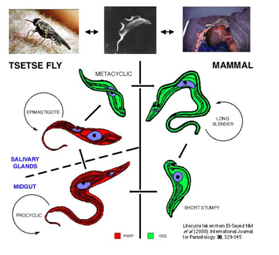News
Latest Lion Aid News
Why have the Tsetse Fly and the Parasite been called the best conservationists in Africa?
Friday 1st October 2010
|
Glossina and Trypanosoma are conservation heroes under threat. Glossina is a biting fly, and Trypanosoma is a protozoan, the tsetse and the parasite. They have been called the best conservationists in Africa and have certainly been responsible for the creation of many of the continent’s national parks and reserves, but neither has been able to turn up at award ceremonies, except perhaps as uninvited guests. This is because Glossina is a biting fly, and Trypanosoma is a protozoan. Put those two together, the tsetse and the parasite, and you have a devastating disease that made large areas of sub-Saharan Africa dangerous for domestic animals. But well-inhabitable for wildlife species that had built up a level of resistance to the disease over millions of years (the oldest tsetse fly fossil comes from, strangely, Colorado in the USA and is estimated at 34 million years old). Clearly, tsetse areas had to be avoided in the early days, and many of such regions became the original African national parks and reserves – the land just could not be used for cattle. Trypanosomiasis, the disease, is also called nagana in Africa (for cattle), and sleeping sickness (for humans). There are over 20 species of tsetse flies in Africa, and a variety of genetically different trypanosomes – but the risk of getting human sleeping sickness on your next safari is actually quite small as it is confined to relatively small pockets and the disease is treatable. But something had to be done, right? Can’t let a mere fly and a protozoan limit the expansion of agriculture! Research programmes were established, the transmission cycle of the parasite was studied, and control measures initiated. Kenya, for example, has the Kenya Trypanosomiasis Research Institute, of course largely funded from overseas, and now under investigation for missing funds. The early tsetse control programmes were often completely misguided, involving the slaughter of wildlife as an example. Since wildlife was seen as a maintenance host for the trypanosomes, get rid of them was the thought – did not work. Later, widespread use of DDT was used in aerial- and ground-spraying programmes. Yes, it was effective against tsetse, but also killed many beneficial insects like bees and of course wreaked havoc with birds (not only the ones that eat insects) and fish. After those debacles, kinder and gentler programmes were attempted. One of them involved the placement of tsetse “traps”. These are essentially blue cloths (tsetse, for some reason, really like that colour – don’t wear that on your safari) treated either with chemical attractants and/or insecticides – and the flies then fall into a collection chamber. This was tried in Botswana, funded by the UK – lots and lots of these traps were put out in wooded areas in the Okavango (Botswana tsetse don’t like open spaces), but elephants and baboons destroyed most of them and maintenance of the traps post-deployment was almost non-existent. Then came the irradiated male concept, courtesy of the Atomic Energy Agency. Dose laboratory-raised male flies with sufficient gamma rays to sterilize them, then release them so reproduction among the wild tsetse would be severely curtailed. Hmmm. Tsetse can produce over 30 generations over their lifetime, so the Atomic Energy Agency’s time would be largely occupied producing the many millions of sterile flies needed to make this a continentally effective programme – so far there has only been limited success on the island of Zanzibar. The other problem was that the flies needed to be zapped far away from wildlife areas and then transported - you can imagine the logistics. So back to chemicals for control. Since trapping was not working in Botswana, a new aerial spraying campaign was devised. Tsetse were rapidly expanding out of the Okavango after wet years in 2002 and 2003, and after some discussion, a specific chemical was decided upon. Special planes were bought and flew endless patterns over the delta and towns at night (all credit to the pilots, they had to maintain specific height, speed, and formation at night as there was then little wind to interfere with effective chemical distribution). And it really worked. No more tsetse, and the other insects seemed relatively unaffected. People in the towns complained of some funny symptoms but hey – all for the greater good (can you imagine aerial spraying of insecticides over towns in Europe to protect cows?). But is it for the greater good? Without the insect and protozoan guardians, parks and reserves are now invaded by cattle. Game scouts are under-equipped, wildlife department heads seem to have developed sleeping sickness in their air-conditioned offices, and politicians… well… Meantime, let’s all nominate Glossina and Trypanosoma for an award in absentia for their past wildlife conservation efforts? Picture: www3.imperial.ac.uk/portal/pls/portallive/docs/1/20645696.JPG Tags: wildlife diseases, Tsetse Fly, Glossina, Trypanosoma, sleeping sickness, Nagana, Categories: Wildlife Diseases |
Add a comment | Posted by Pieter Kat at 15:12




